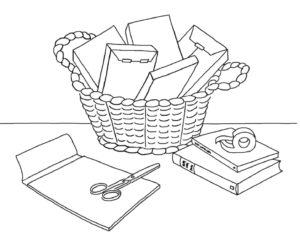Procedure:
- The instructor places one book for each student into a bag, made of colorful gift wrap paper (subsequently this can also be done by older students). All these goodie bags are then placed into a basket and presented to the class. It might be useful to use different colors for different age groups (red bags = for the little ones, blue: 4th–6th grade, green: 7th–9th grade).
- Each child may take a “goodie bag” and unwrap the book hidden in it. At least 10 minutes should now be allocated for a first reading, leafing and browsing through the book. If a child already knows the book or is absolutely unable to do anything with it, s/he may exchange it through the teacher.
- At the end of the sequence, the students take the books home to read or have it read to them. After a week or two, the books are returned to the school. The students tell each other about what they have read, compare theirs with others, and give each other reading tips.

Alternatives:
In the goodie bags or packages, respectively, there are books which the students already know (e.g. books which the instructor had read to the students in the course of the year, or which had been presented by other students). The students inform themselves one more time precisely about the content of their book (without showing it to the other students) and write down riddles for it. These question are then posed to the other students who will try to guess the name of the book in question. Example for riddle questions: “the main character’s father in my book is a king”, “the story of my book takes place is our native country about 1000 years ago”, “the main character in my book has two red pigtails”. The first information should be very general; still, if nobody guesses correctly, more and more specific information is made available. (See also the idea #13 riddle string)






